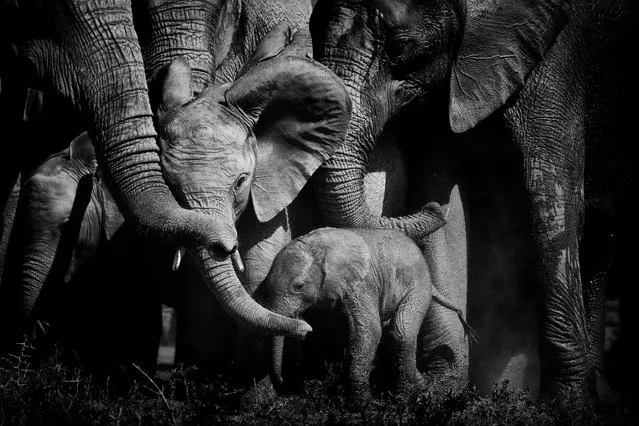
Bonds of love by Peter Delaney, Ireland/South Africa. Peter was photographing the herd in Addo elephant reserve, South Africa, when the newborn let out a shriek. A bull elephant had been trying to separate the calf from its mother. The herd reacted instantly – blowing loud calls, flapping ears, then surrounding the young and reaching out their trunks for reassurance. Elephants create bonds that last a lifetime, and they can show emotions from love to anger. Peter says: “There is something magical and beautiful when you observe elephants – it touches your soul and pulls at your heartstrings”. (Photo by Peter Delaney/Wildlife Photographer of the Year 2021)
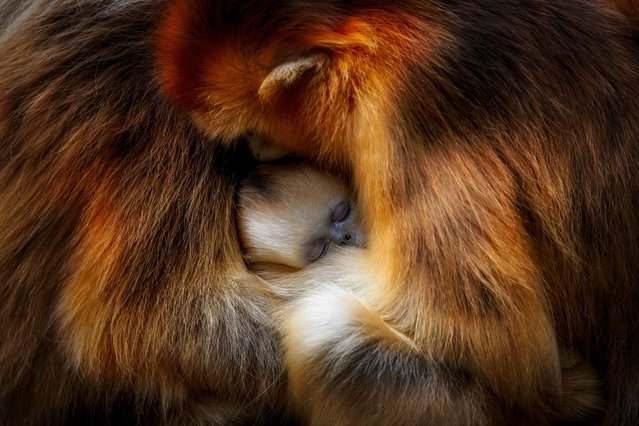
Monkey cuddle by Zhang Qiang, China. Zhang was visiting China’s Qinling mountains to observe the Sichuan snub-nosed monkey. The mountains’ temperate forests are the endangered monkeys’ only habitat, which is also under threat from forest disturbance. Zhang loves to watch how friendly the family groups are to each other. When it is time to rest, the females and young huddle together for warmth and protection. This image perfectly captures that moment of intimacy. The young monkey’s unmistakable blue face nestled between two females, their striking golden-orange fur dappled in light. (Photo by Zhang Qiang/Wildlife Photographer of the Year 2021)
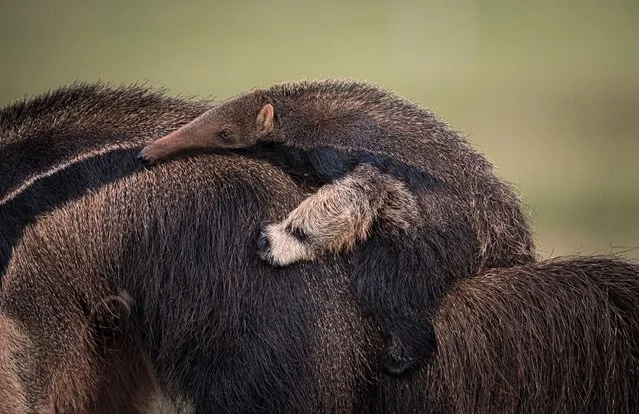
Hitching a ride by Wim van den Heever, South Africa. A female giant anteater was foraging around an open plain late one afternoon in the Pantanal, Brazil, when Wim noticed she had a youngster on her back. He instinctively grabbed his camera and slowly crept up to a termite mound in the direction she was moving in. Sitting quietly, he waited for her to make her way over. The light was fading, and he began to wonder if he’d have time to capture the scene. After waiting quite some time – anteaters walk slowly – and holding some very heavy camera equipment, Wim was rewarded for his patience. (Photo by Wim van den Heever/Wildlife Photographer of the Year 2021)
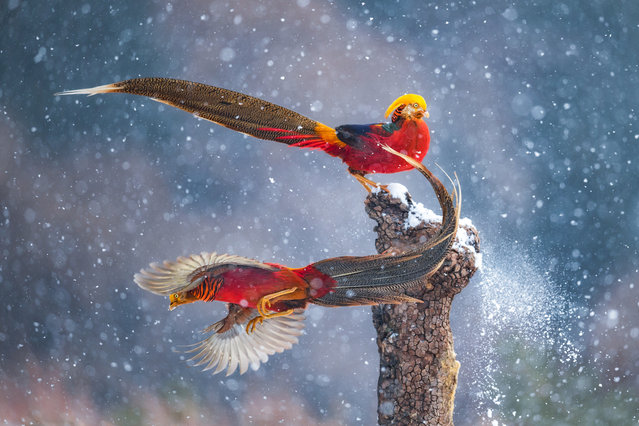
Dancing in the snow by Qiang Guo, China. In the Lishan nature reserve in Shanxi province, China, Qiang watched as two male golden pheasants continuously swapped places on this trunk – their movements akin to a silent dance in the snow. The birds are native to China, where they inhabit dense forests in mountainous regions. Although brightly coloured, they are shy and difficult to spot, spending most of their time foraging for food on the dark forest floor, only flying to evade predators or to roost in high trees during the night. (Photo by Qiang Guo/Wildlife Photographer of the Year 2021)
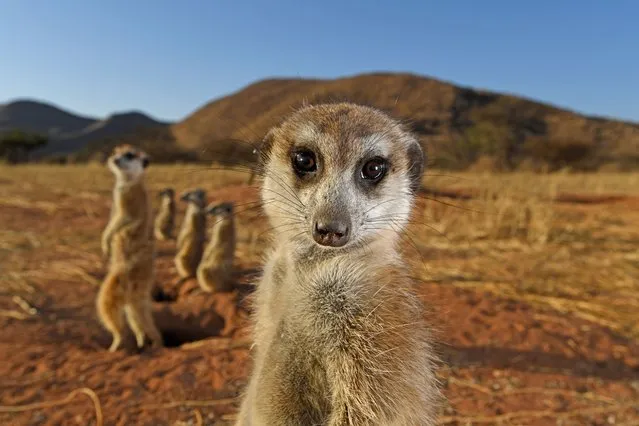
Meerkats put on a pose by Thomas Peschak, Germany/South Africa. This group of meerkats in South Africa’s Tswalu Kalahari reserve have been habituated to humans for over a decade and very relaxed around people. In fact, they mostly ignored Thomas’s presence, too preoccupied with lounging, hunting, grooming and fighting. He was therefore able to get in close and use a wide-angle lens to include the arid savannah and mountains the meerkats call home. To capture the meerkat’s features, he applied techniques used for people in a portrait session, and used studio lights. (Photo by Thomas Peschak/Wildlife Photographer of the Year 2021)
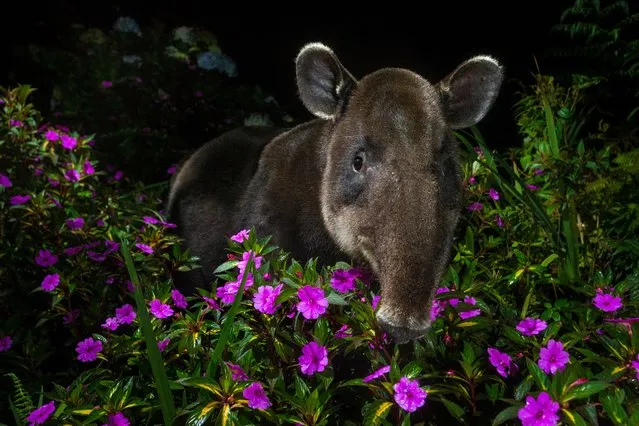
Peek-a-boo by Michiel Van Noppen, the Netherlands. Michiel took this photo of Dantita, as she is fondly known, at the foothills of Braulio Carrillo national park, close to San José in central Costa Rica. The Baird’s tapir, or “gardeners of the forest”, are extremely important to their natural habitat, with some seeds only germinating after passing through the tapir. But owing to threats from deforestation and hunting, there are estimated to be only 6,000 left in the wild. (Photo by Michiel van Noppen/Wildlife Photographer of the Year 2021)
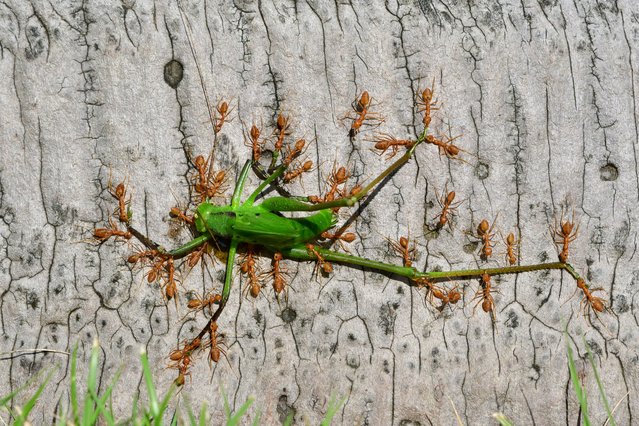
Working together by Minghui Yuan, China. Minghui had noticed green tree ants in the Xishuangbanna tropical botanical garden in Yunnan province, China, and was fascinated by their behaviour. Ferocious by nature, these ants are good at catching all kinds of insects and one morning Minghui noticed a group working together to restrain a green katydid. These ants don’t always kill: they have been observed ‘farming’ some insects, including leaf hoppers. The ants offer leaf hoppers protection from predators and parasites so that they can feed on the sweet sap the leaf hoppers excrete. (Photo by Minghui Yuan/Wildlife Photographer of the Year 2021)
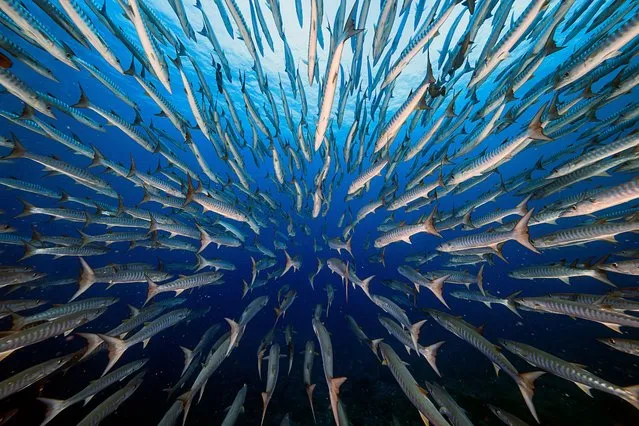
Barracudas by Yung Sen Wu, Taiwan. Yung had been swimming with the schooling barracudas at Blue Corner, Palau, in the western Pacific for four days, but their formation constantly changed shape and he could not find the perfect angle. On the fifth day his luck changed when the fish seemed to accept him into the group. Surrounded by the barracudas, he started to imagine how one fish sees another while swimming, and this was the picture he wanted. The fish were fast, and he had to swim hard to keep his place in the school. At the end of an exhausting 50 minutes, he got his perfect “fish eye” view. (Photo by Yung Sen Wu/Wildlife Photographer of the Year 2021)
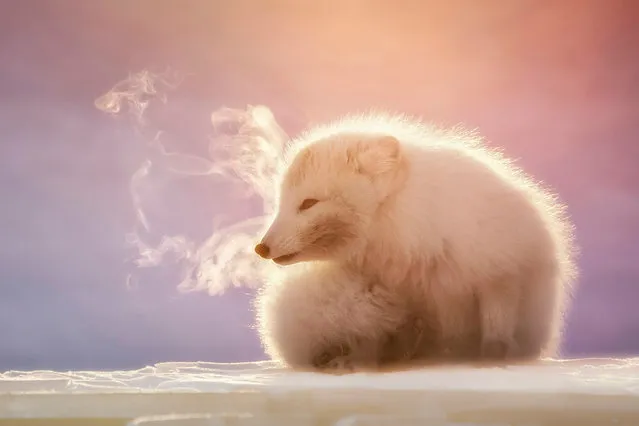
Breath of an Arctic fox by Marco Gaiotti, Italy. Marco was watching this little Arctic fox as it incessantly called another nearby. Gradually he noticed the fox’s wet breath was quickly freezing in the air after each call. It was late winter in Spitsbergen, Svalbard, and the air was -35C (-31F). Photographing Arctic foxes is often frustrating, as they are normally running around fast in search of food, but this one was very relaxed and let Marco get close enough to focus on it, with the light glowing perfectly in the background. (Photo by Marco Gaiotti/Wildlife Photographer of the Year 2021)
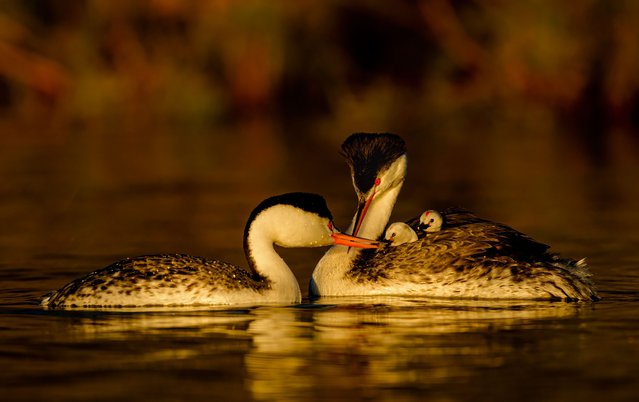
All together by Ly Dang, US. The Clark’s grebes on Ly’s local lake in San Diego did not nest for a few years. Then, in 2017, California had twice its normal annual rainfall. With the lakes full, the grebes started building their floating nests among the reeds or rushes and laying eggs again. The chicks hitch a ride on a parent’s back soon after hatching. This picture was taken a few days after a storm which sadly washed away almost all of the grebes’ nests. Ly had been out on a boat for hours looking for grebes and, just as the light was fading, he spotted the survivors. (Photo by Ly Dang/Wildlife Photographer of the Year 2021)
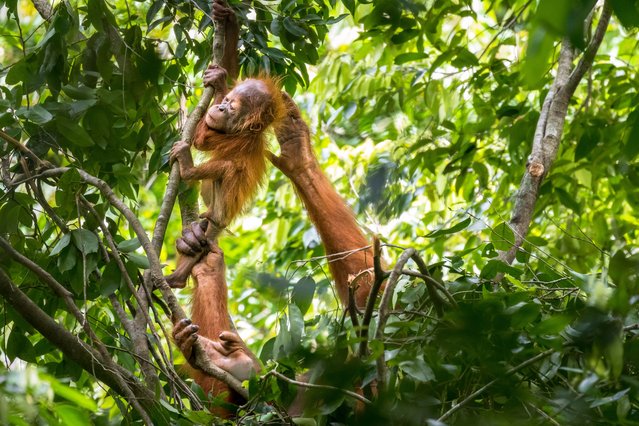
Stay close by Maxime Aliaga, France. Maxime spent more than an hour observing this mother in the Hutan Pinus/Janthoi nature reserve in Sumatra, Indonesia, trying to keep her excitable baby in the nest. Since 2011 the Sumatran Orangutan Conservation Programme has released more than 120 confiscated apes into the reserve with the goal of establishing new wild populations. This mother, Marconi, was once held captive as an illegal pet, but was nursed back to health and released in 2011. In 2017 she was spotted with a wild-born baby, Masen, a symbol of hope for the future population. (Photo by Maxime Aliaga/Wildlife Photographer of the Year 2021)
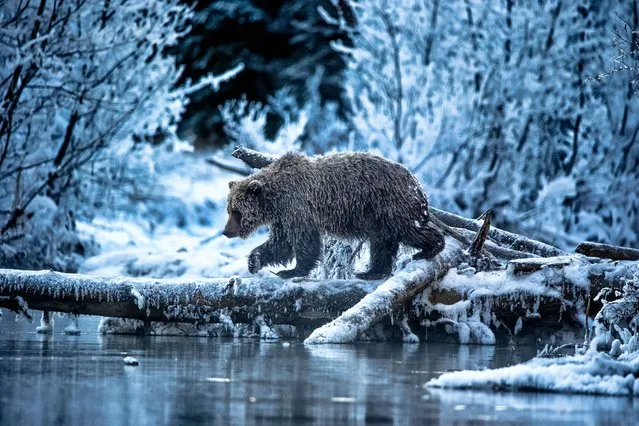
The ice bear cometh … by Andy Skillen, UK. It is a two-hour helicopter ride from the nearest town to this spot on the Fishing Branch River in Yukon, Canada, where the river never freezes. The salmon run occurs in late autumn here, and for grizzly bears this open water offers a final chance to feast before hibernating. It was averaging around -30C (-22F) and Andy had been waiting, hoping one particular female bear would use this log to cross. Eventually she did and he got the picture he’d envisioned – her wet fur had frozen into icicles and “you could hear them tinkle as she walked past”. (Photo by Andy Skillen/Wildlife Photographer of the Year 2021)
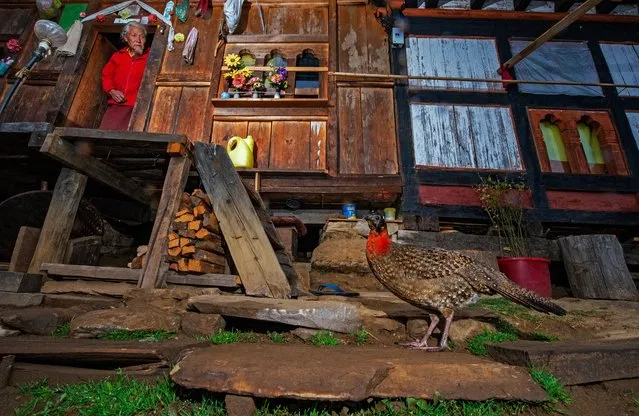
Living together by Dhritiman Mukherjee, India. Satyr tragopans, a rare species of Asian pheasant, are widely hunted for food and plumage, and are normally skittish and very shy. But in this village near Punakha, the birds appear at ease and perfectly relaxed among the people who live there. Dhritiman had been trying to photograph the satyr tragopan in India since 2008, but the birds would always run away when they spotted him. After hearing of communities in Bhutan coexisting harmoniously with the species he knew he had to witness it for himself. (Photo by Dhritiman Mukherjee/Wildlife Photographer of the Year 2021)
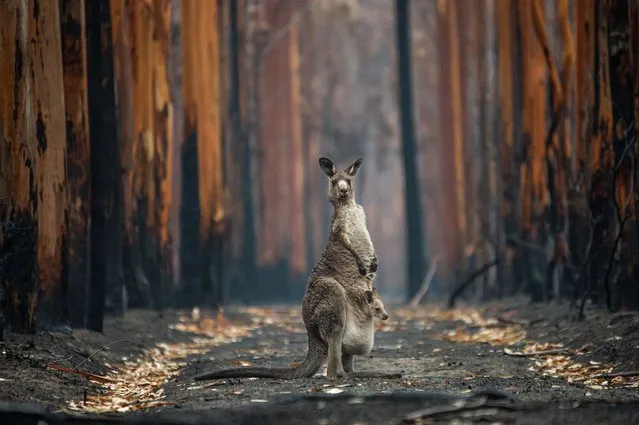
Hope in a burned plantation by Jo-Anne McArthur, Canada. Jo-Anne flew to Australia in early 2020 to document stories of animals affected by the devastating bushfires in New South Wales and Victoria. Working alongside Animals Australia she was given access to burn sites, rescues and veterinary missions. This eastern grey kangaroo and her joey, pictured near Mallacoota, Victoria, were among the lucky ones. The kangaroo barely took her eyes off Jo-Anne as she walked to the spot where she could get a great photo. She had just enough time to press the shutter release before the kangaroo hopped away. (Photo by Jo-Anne McArthur/Wildlife Photographer of the Year 2021)
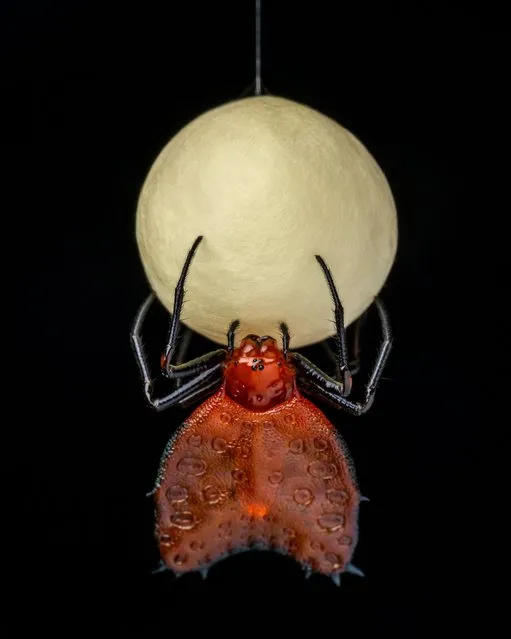
Building an egg case by Javier Aznar González de Rueda by Spain. While out on a night walk in the Amazon rainforest near Tena, Ecuador, Javier spotted this little female thorned heart orb weaver spider delicately constructing her egg case. Hanging from a strong silk thread, these female spiders spend hours encasing their eggs in a silken cocoon, which may contain several hundred eggs. On this dark night, the egg case resembled a pearly white full moon. (Photo by Javier Aznar González de Rueda/Wildlife Photographer of the Year 2021)
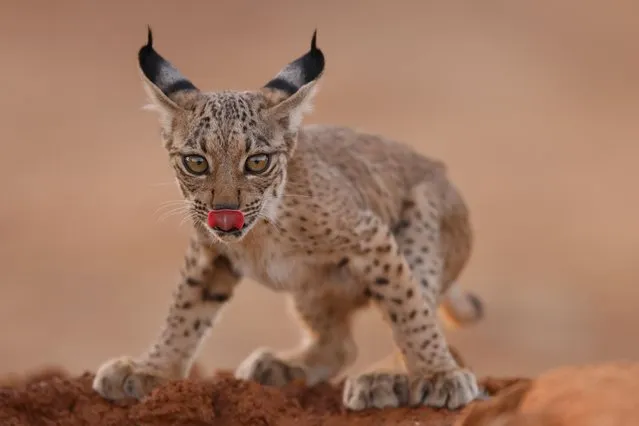
Lynx cub licking by Antonio Liebana Navarro, Spain. Iberian lynx are one of the world’s most endangered cats due to habitat loss, decreasing food sources, car hits and hunting. Thanks to conservation efforts the species is recovering and can be found in areas of Portugal and Spain. Antonio captured this image while leading a conservation project based around photography in Peñalajo, Castilla La Mancha, Spain. He knew a family of lynx used this waterhole, so he rigged up a hide close by. He was lucky enough to capture the moment the cub lifted its head, licked its lips and gazed into the camera. (Photo by Antonio Liebana Navarro/Wildlife Photographer of the Year 2021)
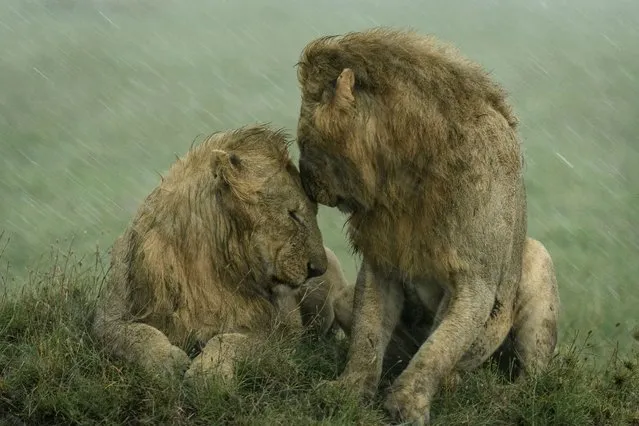
Shelter from the rain by Ashleigh McCord, US. During a visit to the Maasai Mara, Kenya, Ashleigh captured this tender moment between a pair of male lions. At first, she had been taking pictures of just one of the lions. The second lion had briefly approached and greeted his companion before choosing to walk away, but as the rain turned heavy, he returned and sat, positioning his body as if to shelter the other. Shortly after they rubbed faces and continued to sit nuzzling. Ashleigh stayed watching them until the rain was falling so hard that they were barely visible. (Photo by Ashleigh McCord/Wildlife Photographer of the Year 2021)
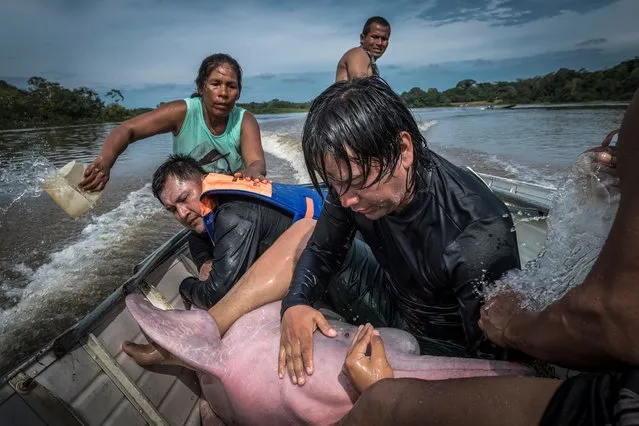
Dolphin hug by Jaime Rojo, Spain. Jaime watched as Federico Mosquera, a biologist from the Omacha Foundation, Colombia, soothed an Amazon river dolphin. These dolphins are tactile animals and direct contact calms them. The team from Omacha and WWF were transporting the dolphin to a temporary veterinarian facility in Puerto Nariño to install a GPS tag in its dorsal fin as part of a project researching river dolphin health and migratory patterns. The goal was to tag five, but high waters gave the dolphins a wider roaming range than usual, and the crew tagged only one during the expedition. (Photo by Jaime Rojo/Wildlife Photographer of the Year 2021)
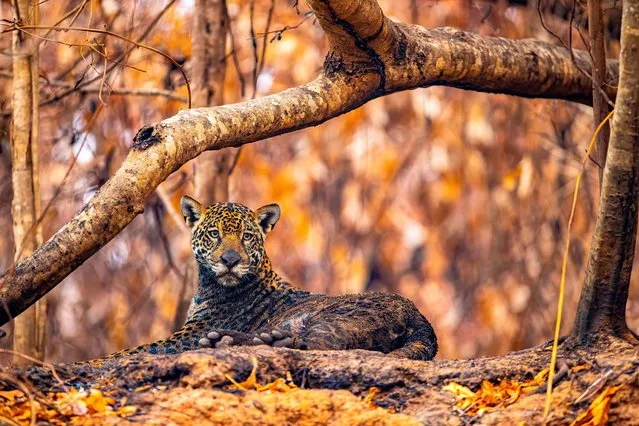
Jaguar of ashes by Ernane Junior, Brazil. Fires in Brazil’s Pantanal wetlands more than doubled in 2020 compared with 2019. More than 26% of the total area was affected while in Encontros das Águas State Park roughly 80% was burned. The park is known for its large jaguar population and Ernane was there documenting the fires when this jaguar and his brother crossed the Rio Três Irmãos (Three Brothers River) nearby. After reaching the opposite bank, the jaguar rolled in the ash, leaving only his face uncovered, his now black body mirroring his charred surroundings. (Photo by Ernane Junior/Wildlife Photographer of the Year 2021)
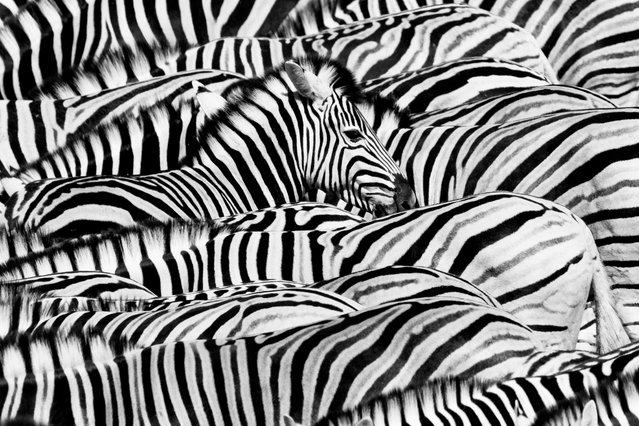
Life in black and white by Lucas Bustamante, Ecuador. Dozens of plains zebra had showed up to drink at Okaukuejo waterhole in Etosha national park, Namibia – a popular location for the animals of the area to quench their thirst. (Photo by Lucas Bustamante/Wildlife Photographer of the Year 2021)
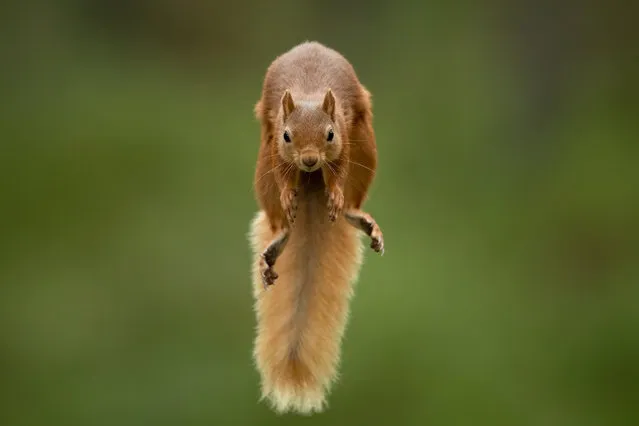
The jump by Karl Samitsch, Austria. While visiting the Cairngorms, Scotland, a friend took Karl to a forest where red squirrels were used to being fed. They placed hazelnuts on opposite branches of two trees and Karl positioned his camera on a tripod facing the direction a squirrel might jump. Setting his camera to automatic focus, he waited behind a tree, holding a remote control. After less than an hour, two squirrels appeared. As they leapt between the branches, he used the high-speed burst mode on his camera, and of the 150 frames, four were sharp, and this one perfectly captured the moment. (Photo by Karl Samitsch/Wildlife Photographer of the Year 2021)
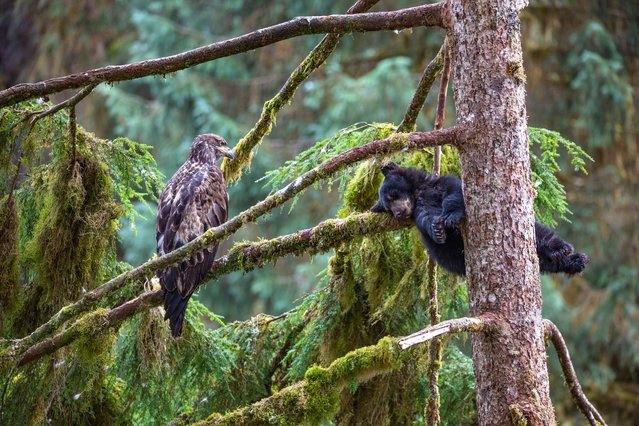
The eagle and the bear by Jeroen Hoekendijk, the Netherlands. Black bear cubs will often climb trees to wait safely for their mother to return with food. Here, in the depths of the temperate rainforest of Anan in Alaska, this little cub decided to take an afternoon nap on a moss-covered branch under the watchful eye of a juvenile bald eagle. The eagle had been sitting in this pine tree for hours and Jeroen found the situation extraordinary. With some difficulty, and a lot of luck, he was able to position himself a bit higher on the hill and take this image as the bear slept on, unaware. (Photo by Jeroen Hoekendijk/Wildlife Photographer of the Year 2021)
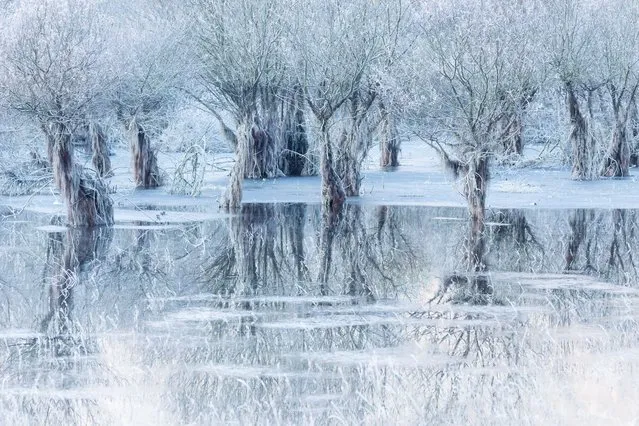
Lake of ice by Cristiano Vendramin, Italy. Santa Croce Lake is a natural lake located in the province of Belluno, Italy. In winter 2019, Cristiano noticed the water was unusually high and the willow trees were partially submerged, creating a play of light and reflections. Waiting for colder conditions he captured the scene in icy stillness. After taking the image, he was reminded of a dear friend, who had loved this place and is now no longer here. “I want to think he made me feel this feeling that I’ll never forget. For this reason, this photograph is dedicated to him”. (Photo by Cristiano Vendramin/Wildlife Photographer of the Year 2021)
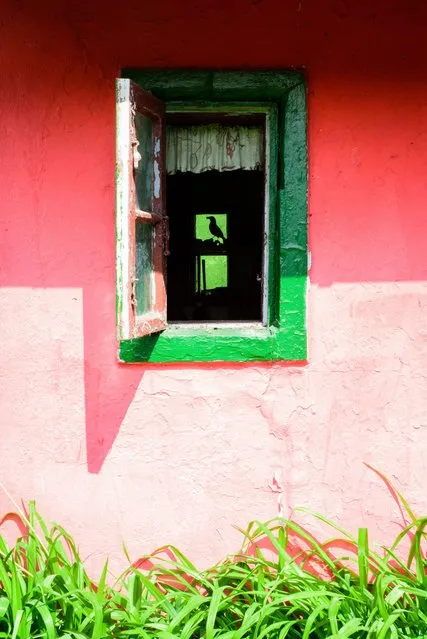
Blackbird backyard by Jan Leßmann, Germany. Jan took great pleasure in watching this blackbird from his front door, in his home town of Greifswald, Germany. It was spring and the blackbird had chosen an old garden hut in which to build her nest. Quietly and secretly she raised her young in this garden idyll. With this image Jan wanted to highlight that we don’t have to go far to experience the beauty of nature – sometimes something as simple as a blackbird making her home in a rundown hut is enough. (Photo by Jan Leßmann/Wildlife Photographer of the Year 2021)
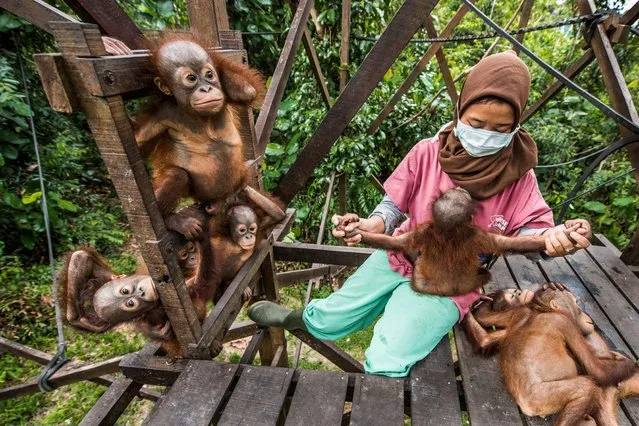
The future in her hands by Joan de la Malla, Spain. Due to industrial logging and land clearing for plantation development, the rainforests of Borneo are disappearing fast. Because of this, endemic species such as the orangutan are suffering and dying and are under serious threat. International Animal Rescue rehabilitates orphaned or injured orangutans, giving them the health care they need and preparing them for reintroduction, when possible. Here, in a forest enclosure, a keeper takes care of babies who are encouraged to mix with others of a similar age, make nests and forage for food. (Photo by Joan de la Malla/Wildlife Photographer of the Year 2021)
05 Dec 2021 06:36:00,
post received
0 comments
